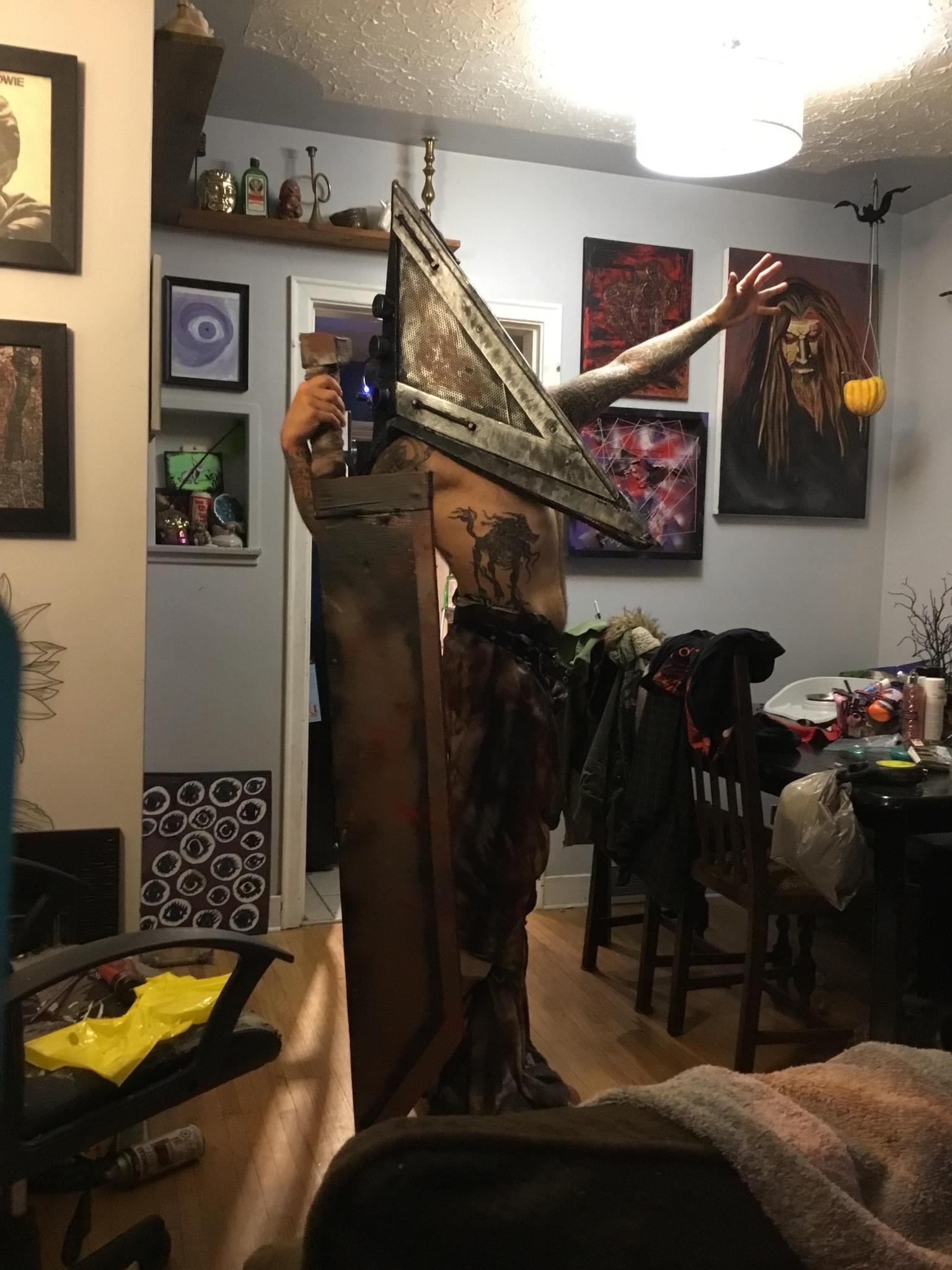Maybe something you learned the hard way, or something you found out right before making a huge mistake.
E.g., for audiophiles: don’t buy subwoofers from speaker companies, and don’t buy speakers from subwoofer companies.
deleted by creator
Protection goggles when removing supports from your resin 3D prints. ALWAYS
Personal Protective Equipment is super important for many activities and are neglected far too often.
The best way to write a good story, for me, is to write a story I want to read. That seems obvious but bear with me. If I plan out all the details, it’s like someone spoiled the book for me, I just can’t get into it. I have to create characters I’m interested, plunk them in a situation, and just start seeing what happens. I dont fret the little details unless they start getting me into a place I’m not enjoying. Later on I go back to the early parts and tie them together with whatever happened. Done this way, writing a story feels like reading a story, one that is specifically tailored to your own interests (and that none of your friends have read, so they can’t talk to you about it)
A fun way to get started with a story is to take two actors and put them together.
Natalie Portman and Keanu Reeves are the stars of the story. Now tell me the plot.
A person would have to known actors much better than I do for something like that, lol
Don’t use thick lube for unresponsive yoyos and vice versa. Thick lube will make an unresponsive yoyo more responsive which you don’t want.
And don’t stress about playing a soulslike a certain way and don’t listen to gatekeeping haters. Play whatever way you want - it’s a game after all and you bought it for your pleasure
I was very concerned reading those first few words
:^]
People are surprisingly easy to manipulate.
What niche hobby of yours does this rule apply?
It’s just a Town of Salem game, right? Right?
So this is where the fediverse chick came from huh haha
Ancient coins (2000-1700 years old) are surprisingly common and can be had very cheaply unless you want a specifically rare or perfect one.
I went through most of my life believing that anything older than say 200 years was automatically a museum piece or equivalent. But most museums of ancient history who display ancient coins have multitudes of the displayed coins sitting in storage. The Romans alone minted BILLIONS of coins over the span of the Republic and the Empire (that’s over 1000 years of history!) and if even 1% of them survive today, that’s still many, many dozens of millions.
deleted by creator
V-coins and ma-shops are reputable and you won’t easily come across fakes there. Just stay away from Ebay and the like. Also, if you go for the affordable types (common denari or late roman bronzes) these are almost never faked since it’s not worth the effort. They cost like 5 bucks for decent pieces, maybe just a bit more if you want a nicer specimen.
Yeah, Im curious about that too
deleted by creator
Yeah but to really cement the look you need a leather coin purse that hangs from your sword belt.
deleted by creator
Also America’s definition of old and Europe definition of old are very different. My family in England live in a house that’s older than America and not by a little.
Cool!!!
If you are dungeon mastering I would recommend avoiding the Quantum Ogre as much as possible. The idea here is to use the same encounter depending on whatever decision the party chooses. This is tempting because this reduces prep work and can reuse information. However, if the decision doesn’t have any consequence why make the players make this decision? TTRPG are about collaborative story telling so decisions so matter and if they don’t why am I even playing. If you want to reduce your prep maybe have the same monsters but at least change the terrain or starting criteria.
If there is decision lead clues about what might be different between the options if it is important decision. These clues might not be obvious but that is what skills checks are for. Make decisions worthwhile so players feel engaged
Man, this one is loaded. I use variants on the quantum.ogre all the time, and am widely considered to be an excellent dm. It’s not about the ogre, it’s about whether choices have an impact on the story. They can still do that even if minor parts of the set dressing - like whether or not you’ll fight an ogre around the corner because you the DM spent ages prepping that encounter - are relatively constant
It’s not about the ogre, it’s about whether choices have an impact on the story.
This is exactly my point is that by relying on it constantly there is no actual real choice and its just lying about railroading the players. If I have the choice about going to clear out the undead in the forbidden temple or clear out the bandits on the outskirts of town and behind the scenes its the same dungeon map I will never know nor will I care. But if I go to kill the undead at the forbidden temple and end up at the bandit camp why make this choice? I love being able to re-use material like this, (In fact I had a dungeon that was an extra-dimensional space where the players got to choose between monsters and demons which used the same map). Same thing if a group of assassins is coming to attack the party and they are deciding between going shopping or the spa. The assassins will find them either way at whatever place they are doing. This is a great use. But if I heard rumor about these assassins and attempt to hide from them but no matter what I do they will always find me that is removing choice.
I think its more of an advanced technique that given as some beginner friendly advice. Its easy to use it all the time to reduce agency instead of using it sparingly.
The same basic encounter can have different effects in different contexts.
Maybe clearing the bandits is how you find a stolen artifact that helps you clear the forbidden temple. Fighting the same enemy in a back alley has different consequences from doing it in the busy street. The ogre down path A might be mechanically identical to the one down path B, but they’re from rival tribes.
It can definitely be used incorrectly, but there are lots of ways for that non-choice to really be a meaningful choice.
In Magic the Gathering it’s usually correct to wait to play instant spells until your opponent’s turn, either on their upkeep or end step in most cases. Waiting as long as you can gives you more information to make the best play.
Just buy a good 3d printer for your first. Sure, it’ll cost money, but the heartache of constant troubleshooting and tweaking can just suck the fun out of the hobby if you just need this print to succeed.
Prusa Mini+ (I think) Bambu A1 Mini (this would be my #1 starter printer before the security updates they done)
Good one. I struggled for years with a monoprice printer I basically got for free because Rakuten marketplace was shutting down and I had to use my rewards. I recently got a Bambu printer as a gift and it’s so much better at the same tasks, plus the additional features make me regret spending time upgrading my MP10.
But if you get a cheap one you get a free crash course on everything that could possibly go wrong on a print and how to avoid it.
Ender 3 btw
One of those hobbies where starting cheap actually makes it not worth it. Kind of like a cheap camera can make you feel discouraged once you get pretty good at photography. A $500 camera can get you started, but a $1500+ (or refurbished more expensive option) will unlock a whole new level of creative abilities (speaking from experience!)
What would you say the gap between the “this 3d printer will do the job but make you lose your mind” and “this is a reliable 3d printer that is reasonably priced for hobbies”?
I kinda disagree with this, in certain contexts. There is some value in learning how the machine works by self-assembling a kit (or buying off-the-shelf parts and assembling from an open-hardware guide). Identifying the things that can be upgraded, tinkering with firmwares and nozzles, printing parts to upgrade the machine itself… all are a fun aspect of the hobby, if you’re interested in the hardware side.
But if you just want to make figurines from squirty plastic, then yeah just buy a moderately-priced, well-supported turnkey printer (though probably not a Bambu, because they’re sliding toward enshittification).
If not bambu, what do you recommend?
Current sovol sv07 plus user and facing this wall where I can’t decide if it’s a skills/knowledge issue or a hardware limit.
Sovol has been generally decent in my experience (SV08), but they’re kinda positioned between the “tinker” and “turnkey” markets. What wall are you running into?
Bambu would have been my recommendation before they tried to lock people into the cloud connection. They’ve reversed course (for now) due to the backlash, but they’ll do it again when they think they can get away with it.
At this point I’d probably say Prusa, but I don’t have firsthand experience with them so that’s based solely on what I’ve read. If you’re looking for something that will “just work” you’re going to need to search for what’s in your price range and then read everything you can about the models in question on support forums and reddit (ew). You can also learn a lot by watching YouTube videos but you have to be really careful to see past the “they gave me this for free/paid for the video so I’m going to minimize the negatives” crap.
Right now I have bunch of settings saved that results in a pretty decent PLA print, but it takes ages. (Layer of .15, print speed 50-100, gyroid infill 15%. Bed 60* nozzle 210). And I tried to print a tube to put coins in and it’s 5 hours. And the threads didn’t come out great.
Overhangs get me usually, but sometime later adhesion if I dare use the ultimate presets like “course”, even if I adjust the temp.
Also I tried updating utlimaker to the latest version, rather than the one it comes with, and then was a disaster that lead me down a rabbit hole to Orca.
Which was another rabbit hole that my partner had to emotionally support me through as the equivalents of “PCLOADLETTER” would trash my prints on a whim. Usually 3/4 of the way through.
I bought this printer to print dust collector fittings and adaptors for power tools (I lead a construction team and I’m pro-safety) and I can usually get a print strong enough for the job, if not pretty.
But I’d like pretty…I’d like to be able to fine tune a print so it’s sexy and strong and also didn’t take 16 hours… Boaty takes 20 minutes and o Looks good every time I print so I just don’t get why something not as complex and the same size takes over an hour and doesn’t come out as clean.
It’s possible that you’re going too slow. It sounds nuts, but I’ve seen degradation of print quality on my homebuilt ANET A8 by going with lower speeds and trying to play around with flow rates.
What I ended up doing with that machine was printing a series of temperature columns, flow rate columns, and speed columns to zero in on the smoothest print. I did all that with my most commonly used PLA and then PETG. I’ve had to make very small tweaks for some variants (for example, matte PLA requires about 4% more flow rate than my baseline).
It’s been years so I don’t remember exactly, but I think I went through three loops of the towers: Find best temp (five degree steps between 180-220C), use that temp to find best flow rate, use those two to test speed. Loop back and do each test again using the best result from the prior two and adjusting each floor of the tower in smaller increments. I think I only had to do temp twice. My profile for that machine and my bulk 3DMARS PLA filament is 208C at 105mm/s and 103% flow rate.
The SV08 that I’ve been using recently is a completely different animal (corexy vs bedslinger). I haven’t had to tweak much at all to get ridiculously fast and good quality prints. I’m actually about to install the enclosure kit and try out ABS for the first time. Since I set up this machine I haven’t even powered on the A8.
Also, have been using Orca exclusively without issue so I can’t really lend advice there.
Good luck!
Thanks for the advice. I’ll go back and do some more tower tests, but (and again, this could be a skill/understanding issue) I don’t really understand how to get a print to change temp mid print, without using the touchscreen and staring at it waiting…
Great point! It also depends on how much time you have for it. I built a 3D printer when I was younger because I had hours most days to work on it.
Now I would probably only have a few hours a week to tinker, so if I spent most of that time just working on the printer and couldn’t get stuff actually printed and printed well, that would feel like wasted time personally!
Would be kinda cool to buy a functioning printer and print parts for a diy printer. Then it’ll have children haha!
Don’t use Sharpies on cheap acrylic paints. They will dry out immediately and be ruined.
Sharpies are made with alcohol-based ink, and alcohol happens to be the perfect solvent for cleaning up dried acrylic paints. So what’s really happening is the tip is getting gunked up with re-wetted paint.
I’d bet you could give the tips of those sharpies a brief soak in some isopropyl alcohol, and/or a firm wipe with a wash cloth or paper towel soaked in the isopropyl, and they could be somewhat recovered (assuming they have plenty of ink in the tank)
That being said, I still would not recommend this practice. Better off with a paint based marker or something.
Thanks for the tip!
I usually learn through trial and error and have found other markers/pens that do work.
For camping, in cold weather switching from being active to resting can be miserably cold. To combat this you can fill a heat tolerant water bottle with some boiled water, wrap it in a shirt or sweater to prevent burning, and put it into your sleeping bag to warm it up quickly. You can also sort of do the reverse for when you wake up. You can put your clothes for the next day in a small bag and sleep with them in your sleeping bag. That way they won’t be frigid when you’re trying to dress.
There’s also the somewhat counterintuitive idea of “be bold; start cold”. Basically, once you get hiking, you’ll get a lot warmer, so you might as well start a little chilly and save yourself getting sweaty 20 minutes in and having to take off a layer.
I used to drag my clothes into bed with me in winter when I was a kid. No central heating, no double glazing, no insulation, no carpets. Might as well have been living in a tent.
Better yet understand that none of your gear makes heat, you do. Think of your sleeping bag and clothes as batteries that need to be recharged periodically and your body is a generator. When you shiver that is your body trying to burn calories to produce heat. You can stay much warmer by keeping busy and moving around than you will by standing around a fire. When you wake up cold in the middle of the night, move your legs like you’re riding a bicycle while laying on your side. It won’t take long to warm up. Also keep an isolating layer between you and the ground like a foam sleeping pad. It also works for when standing on frozen ground.
To combat this you can fill a heat tolerant water bottle with some boiled water, wrap it in a shirt or sweater to prevent burning, and put it into your sleeping bag to warm it up quickly.
The first time I did this I ended up so hot that I had to take it out. Its a wonderful trick and I have woken up spooning the cool water bottle in the morning
I have an old school hot water bottle that I use like this… In my house.
Being a DM is not about telling YOUR story, it’s about coming together with your players to create a story. So even if you are going off a pre-written campaign or story you created, you are incharge of the story. Let the rule of fun reign. If a battle is taking forever you can cut down the number of enemies or the enemy’s abilities. Your in charge and if done right your players don’t even know.
Thanks to the internet you also don’t even need much. Get your hands on a core book and a dice set used by all is all that you need to play. Sure maps and miniatures are fun but some systems don’t need them, some players are perfectly fine with the theatre of the mind play, or some small toys on a self drawn grid on sheet paper can work.
Sure maps and miniatures are fun but some systems don’t need them, some players are perfectly fine with the theatre of the mind play, or some small toys on a self drawn grid on sheet paper can work.
Some big streamers have done massive damage to she hobby by bringing the image that map and miniatures are necessary, and not at best a nice to have, at worst a distraction.
Sure I use sometimes a sketch on paper, but very rarely miniatures, and never accurate ones. Role-playing game isn’t about miniatures
Role-playing game isn’t about miniatures
I feel like miniatures is a separate and interrelated hobby. I don’t really enjoy it but its nice to have something physical for combat. That being said free VTTs do so to replace the need for that.
Best miniature I ever used was a thread spindle he was cloth knight cleric. So I 100% agree with this.
I learned the hard way when jogging and meeting some friends at the bar that even if it’s plus 20 you should bring a sweater with you, because once you’re done jogging and it gets dark you will be cold from the sweat. I did this one time and everyone else in the bar was just fine with their T shirts and I was SHIVERING with my wife beater on. Kind of embarrassing.
When doing snot techniques, 2 studs = 5 plates.
Oh, I didn’t know that conversion, helpful.
Yep, plus the bathroom tile/plates can be easily cleaned with sponges once you’re finished measuring the rocket length.
Servers: it doesn’t have to be built for the purpose. In a pinch, any PC will do.
Chess: Fried liver attack doesn’t work above 700 ELO and is easily countered with a possibility for a smothered mate.
Guitar: Playing 5 minutes every day is better than playing an hour once a week.
These are great and the guitar one is relevant to me right now. Thanks for answering!














